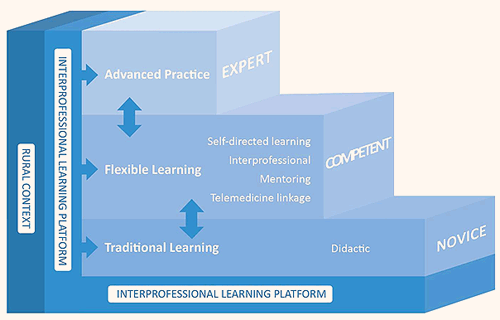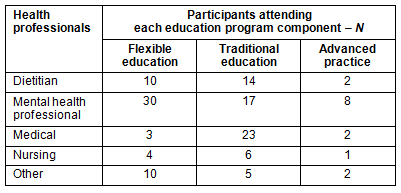Interprofessional learning (IPL) has been well evidenced as a desirable method to promote the awareness of professional roles and increase collaboration and communication among health disciplines1. Interprofessional learning is described as the opportunity for health professions to 'learn with, from and about one another to facilitate collaboration in practice'2. Effective teamwork in health care enhances the potential for improved patient outcomes and supports better patient care. This is especially true with increasingly expectation of health professionals to manage complex health issues in the rural setting3.
The literature examining the efficacy of IPL has specifically highlighted the benefits of increased communication among health professionals promoting an enhanced willingness to work together to provide patient-centred care4. Increased teamwork has also been identified as an approach to address the current issue of fragmentation in care among services3,5. To assist in this process, however, there is a need to improve current methodologies that evaluate the effectiveness of IPL, with greater emphasis on describing the education models used6.
Interprofessional learning is gradually increasing in its application in Australia in line with similar trends occurring internationally. A significant percentage of IPL in Australia is currently directed at undergraduate health professionals7,8.
It could be argued that practicing clinicians working in rural settings have a need to access IPL as much as those at an undergraduate level. Rural clinicians are more likely to work in professional isolation resulting in an increased need to work collaboratively with other disciplines9. This is exacerbated by the limited speciality services available in rural areas with health professionals increasingly required to perform extended roles at an advanced-practice level10.
In Australia, health professionals have mandatory requirements for maintaining continuing education to demonstrate standards of practice11. Difficulties exist, however, for rural health professionals to achieve this due to training locations often being based in metropolitan areas. Additional barriers are the demand for clinical activities to take precedence over education and the expense associated with attending courses12. Improved access to interprofessional learning in rural areas can be addressed through the development of innovative, cost-effective programs which have flexible modes of delivery and incorporate the use of technology10.
In 2009 an interprofessional learning program was piloted as a way to address the barriers related to the delivery of interprofessional education in the rural setting in Australia. The program known as 'Nourishing Networks' originated from the successes of a small but well-established, informal interprofessional eating disorder network located within an Australian rural setting13. This network was originally set up to assist in the management of patients with an eating disorder where collaborative support for health professionals had been lacking. The Nourishing Networks program was supported by a funding grant from the National Rural Primary Health Projects Initiative of the Australian Government Department of Health and Aging. The aim of this program was to provide a variety of educational approaches, build on existing networks and establish new collaborative networks for health professionals.
A description of the interprofessional model will be outlined incorporating the application of the Nourishing Networks learning program, with 'eating disorders' as the education topic. Eating disorders were regarded as an appropriate area for exploring continuing professional development in rural settings due to the need to involve to a range of different services, including medical, dietary and mental health14. The model will demonstrate the flexibility required to meet differing educational needs across a number of health disciplines, while incorporating education that is tailored to varying levels of expertise. The interprofessional approach described within the model will highlight its suitability to the needs of an established health workforce located in the rural Australian setting.
Building rural interprofessional practice
The focus of the Nourishing Networks program was to provide the education needed to demonstrate a triad approach for caring for people with eating disorders in rural settings. The triad approach requires three different health professionals to work collaboratively to provide all necessary aspects of care. Evidence from the literature describes the triad approach as one which incorporates a GP, dietitian and mental health professional as an effective team for managing a person with an eating disorder. Using the funding grant obtained, a project officer was employed and a reference group was established to oversee the development and delivery of the program's educational modules. Many of the members of the reference group were from the the existing local established interprofessional eating disorder network.
The program was conducted across five geographically isolated rural sites in New South Wales, Australia over an 8 month period during 2009. The populations of the five sites ranged from approximately 21 000 to 45 000 with the furthest distance to the nearest metropolitan centre being 525 km15.The rurality of these sites was defined using the Rural, Remote and Metropolitan Areas (RRMA) classification, and all sites classified as RRMA Rural 1 or Rural 2. It was anticipated that clinicians who participated in the program would build upon new and existing knowledge and experience, and through this process would develop greater interprofessional engagement. It was acknowledged by sites participating in the trial program that working with eating disorder patients was a speciality area for which minimal training had previously been provided in rural areas. Health professionals had also identified a lack of specialised services for eating disorders in the rural locations targeted, with an increasing demand for clinician support, knowledge and skills (Pryor D, Little F, Brown LJ; unpubl. data; 2009).
The Stepped Interprofessional Rural Learning (SIPRL) model
The Stepped Interprofessional Rural Learning (SIPRL) model consisted of three separate yet integrated approaches to learning. These included an introductory didactic traditional approach to learning, a self-directed group learning approach and an advanced practice approach. Each component of the model was designed to incorporate IPL as the core element, which interlinked the three stages of the program. The largest component of the model was self-directed learning which included two unique aspects to using an IPL approach. These were the use of telemedicine linking the five sites and the application of interprofessional mentoring.
The model was developed for clinicians in the rural workforce, therefore consideration needed to be given to their varied educational needs. Using the theoretical approach from Benner's research16, applying the novice to expert continuum, the model delivered education in stages with one component building on the next.
All components of the education provided were based upon key principles of adult learning incorporating experiential learning, case-based reasoning, problem-based learning and ultimately skill development. Barr states the most effective education models are those that are interactive17, based on adult learning principles and promote clinicians to be critical and reflective thinkers (Fig1).

Figure 1: Stepped Interprofessional Rural Learning model (developed by F Little and L Brown).
Application of the SIPRL model
Each component of the model could be used as stand-alone segment of the whole program or participants could enrol in all aspects using it as a stepped learning approach towards developing advanced practice. It was expected, but not mandatory, that those who attended the advanced workshops had a degree of competency and experience relating to the management of eating disorders prior to enrolling.
The content of all aspects of the program needed to remain relevant to the professional diversity, experience and interest of the clinicians enrolling in the program. This allowed health professionals to enter the program where they felt the education best suited their needs and experience, with the option for participants to complete all three parts of the learning program, if desired.
The three approaches to learning: The three approaches to learning were: traditional didactic education, flexible learning and advanced practice.
Traditional didactic education The didactic approach to learning was delivered through two workshops. These workshops aimed to promote the development of basic knowledge and skills to manage eating disorder patients in a rural setting. The learning approach was primarily a face-to-face method with interactional discussions promoted at intervals throughout the workshop. One aspect of this workshop was the incorporation of the consumer perspective with some education delivered by a patient who had recovered from an eating disorder.
Flexible learning This was the largest component of the Nourishing Networks program both in the duration of the learning and in participant numbers. The self-directed approach was particularly suited to rural and remote locations because it addressed identified barriers to accessing education. The program funding allowed participants to attend and receive all learning materials at no cost. A flexible education package was developed incorporating five modules delivered over a 10 week period. Upon registration, all participants were provided with a CD-ROM containing program materials.
The self-directed learning approach promoted flexibility for participants to complete the learning objectives when time was available, and provided support in an attempt to decrease professional isolation. Experiential learning was well suited to the Nourishing Networks program as the differing levels of clinical expertise from the participants added to the learning process. A key aspect of this program was the mentoring provided by an experienced interprofessional group. Mentoring occurred through fortnightly sessions using videoconferencing to reach each all of the rural sites simultanously. Interprofessional mentoring was used to assist in the process of clinical reflection and self-care. This promoted clinicians understanding of the difficulties faced when dealing with complex eating disorder patients.
The mentor group included senior health professionals from the fields of dietetics, psychology, mental health nursing and medicine. All mentors selected were those who had interest and expertise in dealing with eating disorder patients. Participants in the self-directed learning component of the program included school counsellors, psychologists, general practitioners, psychiatrists, dieticians, nurses, social workers and occupational therapists.
Advanced practice The advanced practice component of the Nourishing Networks program focused on providing education for the development of specialised psychological skills. Although it was not mandatory, participants were expected to have an intermediate level of expertise for this training to be beneficial. The advanced practice component consisted of a two-day workshop focused on the delivery of the Maudsley method. The Maudsley method is a well-evidenced, family-based treatment approach targeted at improving management of anorexia nervosa and bulimia in adolescents. This early intervention approach focuses on building effective negotiation skills within families and sufferers, and empowers families to bring about recovery for adolescents with these eating disorders18-20. This training involved experiential learning with a large component of small group activities and role playing incorporated into the learning process.
Program outcomes: A total of 137 individuals participated in the program, from a range of health professional backgrounds. Relatively low numbers of nurses and medical practitioners enrolled in the self-directed and advanced practice components of the program (Table 1).
Table 1: Health professional participation in the Nourishing Networks education program

Local networks have developed in two sites since the Nourishing Networks program was delivered and existing local networks have reported an increased number of participants. One established network gained seven additional participants from the Nourishing Networks program.
The SIPRL model addresses some the issues around professional isolation and interprofessional practice in rural areas. It is an example of how IPL can be effectively delivered in a rural context. The challenges engaging GPs in interprofessional learning, given their time constraints, were highlighted as an area requiring further consideration.
Technology, while essential to the model and effective in improving education access to a number of sites simultaneously, did pose issues with the facilitation of discussion, mentoring and opportunities for all sites to contribute. Training in the use of videoconferencing equipment and etiquette was identified by the mentors as needing to be addressed. This was to reduce delays associated with site linking and to maintain participant momentum in the discussion among sites. Access to mentors was incorporated at most sites during the videoconference sessions, once it was identified that facilitation of the session was needed to assist with technical difficulties.
Program mentors provided suggestions for improvements to the program. These included education on adult learning principles, and managing group dynamics for mentors. It was also suggested that allowing longer videoconference sessions would facilitate greater sharing within and among sites
Maintaining participant attendance, especially for the self-directed learning component of the program, became more difficult as the program progressed. Although it was anticipated that there would be a degree of natural attrition, improved methods to communicate with and motivate participants occurred, for example text prompting for upcoming videoconferences. This resulted in a reduction in overall participant numbers leaving the program.
The pilot of the SIPRL model and its application to eating disorders has scope for use in delivering education related to other health topics. The funding provided and free delivery of education was a significant advantage for rural clinicians in reducing barriers to accessing education in rural areas. This highlights the need for further funding incentives to meet the educational needs of health professionals already employed in the Australian rural health workforce.
Acknowledgements
The authors thank the Department of Health and Ageing for the National Rural Primary Health Projects Initiative grant to allow this project to be developed. They also acknowledge the work of Ms Deborah Pryor who was employed as the Project Officer for the duration of the program and those who volunteered as mentors and provided expert input into the program.
References
1. Pullon S, Fry B. Interprofessional Postgraduate education in primary health care: is it making a difference. Journal of Interprofessional Care 2005; 19(6): 569-578.
2. Centre for the Advancement of Interprofessional Education: Homepage. (Online) 2011. Available: http://www.caipe.org.uk/about-us/defining-ipe/ (Accessed 30 June 2011).
3. Gilbert J, Yan J, Hoffman J.A WHO Report: Framework for Action on Interprofessional Education and Collaborative Practice. Journal of Allied Health 2010; 39: 196-197.
4. McNair R Stone N Sims J Curtis C. Australian evidence for Interprofessional Education contributing to effective teamwork preparation and interest in rural practice. Journal of Interprofessional Care 2005; 19: 579-594
5. Garling P. Final Report of the Special Commission of Inquiry: Acute Care Services in NSW Public Hospitals - Overview. Sydney, NSW: NSW Government, 2008. Available: http://www.lawlink.nsw.gov.au/Lawlink/Corporate/ll_corporate.nsf/pages/attorney_generals_department_acsinquiry (Accessed 1 December 2011).
6. Reeves S, Goldman J, Burton A, Sawatzky-Girling B. Synthesis of Systematic Review Evidence of Interprofessional Education. Journal of Allied Health 2010; 39: 198-203.
7. Smith T, Brown L, Cooper R. A Multidisciplinary Model of Rural Allied Health Clinical-Academic Practice. Journal of Allied Health 2009; 38: 236-241.
8. Thistlethwaite J. Interprofessional education in Australasia. Journal of Interprofessional Care 2007; 21: 369-372.
9. Wakerman J, Humphreys J, Wells R, Kuipers P, Entwhistle P, Jones J, Australian Primary Health Care Research Institute. A systematic review of primary health care delivery models in rural and remote Australia 1993-2006. (Online) 2008. Available: http://www.anu.edu.au/aphcri/Domain/PHCModels/Final_3_Wakerman.pdf Accessed 6 September 2011).
10. Smith K, Humphreys, J Wilson M. Addressing the health disadvantage of rural populations: how does epidemiological evidence inform rural health policies and research? Australian Journal of Rural Health 2008; 16: 56-66.
11. Australian Health Practitioner Regulation Agency. Homepage. (Online) 2011. Available: http://www.ahpra.gov.au/Education/Continuing-Professional-Development.aspx (Accessed 14 February 2011).
12. Curran V, Fleet L, Kirby F. Factors influencing rural health care professionals' access to continuing professional education. Australian Journal of Rural Health 2006; 14: 51-55.
13. Harris D, Growtowski M, Brown LJ. Evolution of a rural eating disorder service. In: Proceedings, 7th Annual Conference of the Australian and New Zealand Academy for Eating Disorders; 28-29 August 2009; Brisbane, QLD, 2001.
14. Williams P, Goodie, J, Motsinger C. Treating eating disorders in primary care. American Family Physician 2008; 77: 187-195.
15. Australian Bureau of Statistics. Homepage. (Online) 2011 Available: http://www.abs.gov.au/ausstats/abs@.nsf/Products/3218.0~2009-10~Main+Features~New+South+Wales?OpenDocument#PARALINK21 (Accessed 26 March 2011).
16. Benner P. From novice to expert excellence and power in clinical nursing practice (commemorative edn). London: Prentice-Hall International, 1984.
17. Barr H. Interprofessional education. Today, yesterday and tomorrow. A review. London: Learning and Teaching Support Network (LTSN) Centre for Health Sciences and Practice, 2002.
18. Treasure J, Smith G, Crane A. Skills-based learning for caring for a loved one with an eating disorder - the new Maudsley Method. London: Routledge, 2007.
19. Beaumont P, Hay P, Beumont D, Birmingham L, Derham H, Jordan A et al. Australian and New Zealand Clinical Practice Guidelines for the treatment of anorexia nervosa. Australian and New Zealand Journal of Psychiatry 2004; 38: 659-670.
20. Lock J, le Grange D. Family-based treatment of eating disorders. International Journal of Eating Disorders 2005; 37: 64-67.




